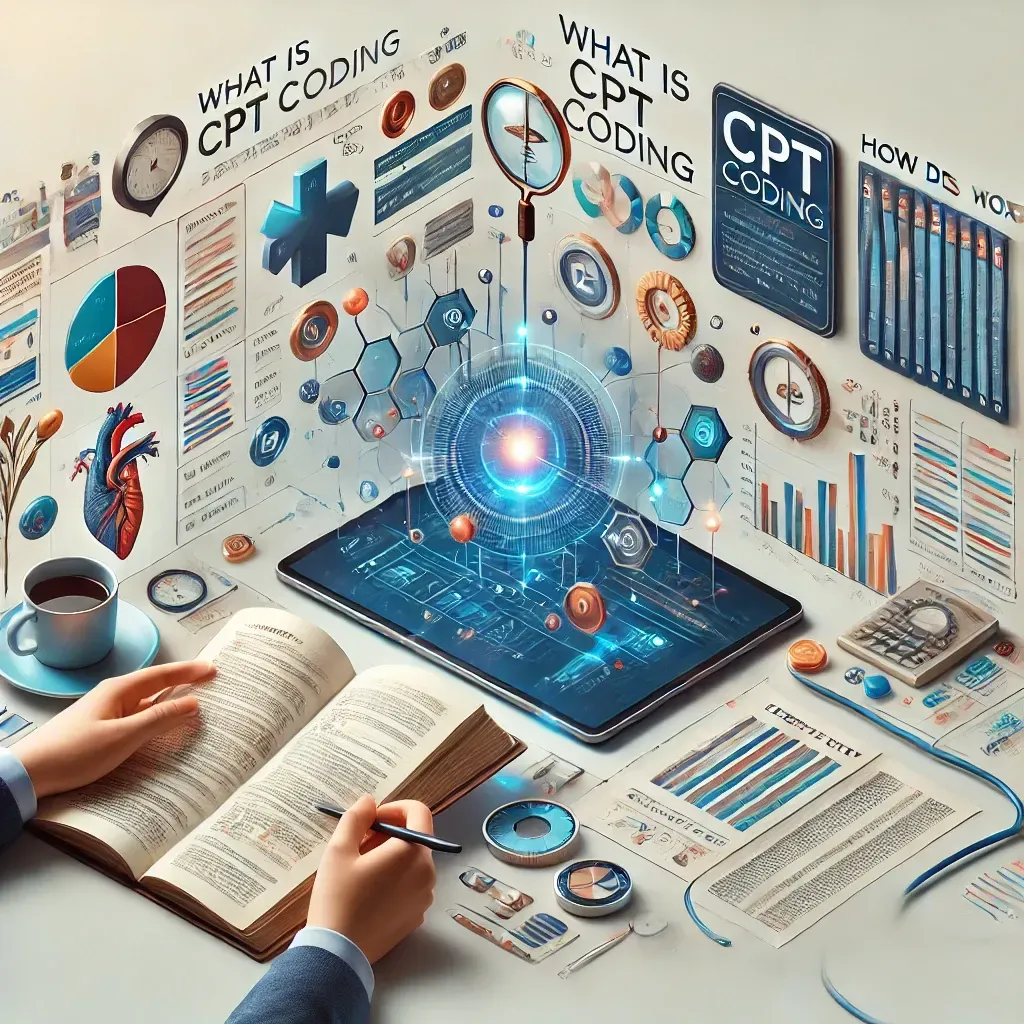

What is CPT Coding and How Does it Work?
What is CPT Coding and How Does it Work?
Introduction
Current Procedural Terminology (CPT) coding is a system used in healthcare to document medical, surgical, and diagnostic procedures. Developed by the American Medical Association (AMA), CPT codes are essential for billing, insurance claims, and maintaining consistent medical records across the healthcare industry. This article explores the basics of CPT coding, how it works, and its importance in the healthcare revenue cycle.
What is CPT Coding?
Definition of CPT Codes
CPT codes are five-digit codes used to describe medical, surgical, and diagnostic services provided to patients. Each code corresponds to a specific procedure or service, allowing healthcare providers to communicate standardized information about the care they deliver.
Purpose of CPT Codes
CPT codes are primarily used for billing and insurance purposes, enabling healthcare providers to submit claims for services rendered. These codes also support data analysis, patient record-keeping, and healthcare reporting, providing a universal language for medical services.
Types of CPT Codes
Category I CPT Codes
Category I codes represent common procedures and services, such as surgeries, office visits, and lab tests. These codes are the most widely used and are organized by sections, including Evaluation and Management (E/M), Anesthesia, Surgery, Radiology, Pathology, and Medicine.
Category II CPT Codes
Category II codes are supplemental tracking codes used for performance measurement. These codes are not used for billing but are instead used to monitor healthcare quality and patient outcomes, helping providers meet specific performance standards.
Category III CPT Codes
Category III codes are temporary codes for emerging technologies and experimental procedures. These codes allow for tracking and data collection on new services, helping assess their efficacy and integration into regular care.
How CPT Codes Are Assigned
Documentation and Medical Records
CPT coding relies on detailed medical records, including clinical notes, diagnosis, and procedure documentation. Coders review these records to determine which procedures were performed and select the appropriate CPT codes.
Using the CPT Manual
Coders refer to the CPT manual to find the correct codes for specific procedures. The manual includes descriptions and guidelines for each code, helping coders accurately represent the services provided.
Applying Modifiers When Necessary
Modifiers adjust the meaning of CPT codes, providing additional details about the procedure. For example, modifiers can indicate if a procedure was performed on both sides of the body, if it was repeated, or if there were unusual circumstances. Coders must apply modifiers carefully to ensure accurate billing and compliance.
Importance of CPT Coding in Healthcare
Supports Accurate Billing and Reimbursement
CPT codes are essential for billing, as they indicate which procedures were performed and support the claims process. Insurance companies rely on CPT codes to determine payment amounts, making accurate coding critical for timely and correct reimbursement.
Standardizes Communication in Healthcare
CPT coding provides a universal language for healthcare services, allowing providers, insurers, and other stakeholders to understand and interpret services consistently. This standardization improves communication across the healthcare system.
Facilitates Healthcare Data Analysis
CPT codes support data collection and analysis in healthcare, allowing for the tracking of treatment trends, patient outcomes, and healthcare utilization. This data is valuable for healthcare research, quality improvement, and public health planning.
Ensures Compliance with Regulations
Accurate CPT coding supports compliance with federal regulations, including HIPAA and CMS guidelines. Coding practices that adhere to compliance standards help avoid errors, reduce audit risks, and maintain the integrity of the healthcare system.
Common Challenges in CPT Coding
Choosing the Correct Code for Complex Procedures
Some procedures have multiple components or require combination codes, making it challenging to select the most accurate CPT code. Coders must understand each procedure’s specifics to assign the correct code.
Staying Updated with Code Changes
CPT codes are updated annually, with new codes added, old ones deleted, and descriptions revised. Coders need to stay current with these updates to avoid using outdated codes and ensure compliance.
Using Modifiers Correctly
Modifiers add complexity to CPT coding, as they adjust the meaning of the primary code. Incorrect modifier use can lead to billing errors or claim denials, so coders must have a thorough understanding of modifier guidelines.
Accurately Interpreting Clinical Documentation
Accurate coding depends on clear and complete documentation. Coders may face challenges if clinical notes are ambiguous or incomplete, requiring clarification from the healthcare provider to ensure the correct code is assigned.
Tips for Accurate CPT Coding
Stay Informed of Annual Updates
Review the AMA’s annual updates to CPT codes, as these changes reflect new medical practices and guidelines. Using current codes prevents claim denials and keeps coding practices up-to-date.
Double-Check Documentation and Codes
Always verify that documentation supports the chosen CPT codes. Cross-referencing codes with clinical notes ensures that they accurately reflect the services provided.
Use Coding Tools and Resources
Coding tools like Codify by AAPC, online databases, and coding software offer quick access to CPT codes, descriptions, and modifiers. These resources simplify the coding process and improve accuracy.
Practice with Real Coding Scenarios
Working on case studies and sample coding exercises helps build proficiency in CPT coding. Practicing with realistic scenarios enhances understanding of complex cases and reinforces coding accuracy.
Resources for Learning CPT Coding
CPT Manual from the AMA
The CPT manual is the official source for CPT codes and includes descriptions, guidelines, and coding conventions. Reviewing this manual regularly helps coders become familiar with the codes and understand updates.
Coding Certification Programs (e.g., CPC)
Certification programs like the Certified Professional Coder (CPC) offered by AAPC cover CPT coding in detail, providing comprehensive training and practical knowledge.
Coding Software and Tools
Coding software, such as Codify by AAPC, provides access to CPT codes, descriptions, and updates. These tools are valuable for finding codes quickly and verifying accuracy.
Professional Organizations and Online Courses
Organizations like AAPC and AHIMA offer coding courses, webinars, and resources specifically focused on CPT coding. Joining these organizations and participating in their educational offerings helps coders stay informed and enhance their skills.
Conclusion
CPT coding is an essential process in healthcare, providing a standardized way to document procedures, support accurate billing, and ensure compliance. By understanding the types of CPT codes, learning how they are assigned, and staying informed of annual updates, coders can improve their accuracy and efficiency. Resources like the CPT manual, certification programs, and coding tools support ongoing learning and skill development, helping coders excel in their roles. Mastering CPT coding is key to a successful career in medical coding and contributes to the smooth functioning of healthcare systems.
FAQs
What are CPT codes used for?
CPT codes document medical procedures and services, supporting billing, insurance claims, and standardized communication across the healthcare industry.
How are CPT codes updated?
CPT codes are updated annually by the AMA to reflect advancements in medical practices, with new codes added, old ones deleted, and descriptions revised.
Why are modifiers used in CPT coding?
Modifiers provide additional information about a procedure, such as location, repeat services, or unusual circumstances, ensuring accurate billing and documentation.
How can I improve my CPT coding accuracy?
Use the CPT manual, stay updated with code changes, practice with coding scenarios, and use coding tools for quick reference and verification.
Where can I learn CPT coding?
Resources include the CPT manual, certification programs like CPC, coding software tools, and online courses offered by professional organizations such as AAPC and AHIMA.
Infinity HIM Medical Coding School
Our focus is your Employment!
Medical Coding Training
We provide the training you need to study and prepare for your Medical Coding career.
Medical Terms I, II
CPT Coding I, II, III
ICD-10-CM I, II, III

Coaching and Mentoring
Get the support you need to transition from school to a well paying job with Infinity HIM!
Interview Techniques & Training
Resume Review and Writing
Mentorship
Career Training/On-the-Job Training
Job Placement Consideration with Partners
Start Your Career in Medical Coding

Enroll Now $897!
Our 8 week course zeros in on the details to help you learn what you need to get a job in medical coding in a highly competitive field. With our training and support, you can have confidence to take the exam and get a job! Get access to all three modules for a special price of $897.


Ready to start looking into the Medical Coding Career?
If you have been thinking about entering this high-paying career, everyone starts by learning Medical Terminology. But you don't have to! I want you to be successful and have the tools you need to achieve your goals in this field.
You can pace your enrollment by ordering the courses separately, allowing you to focus on the aspect of medical coding you need the most.
Module One: Medical Terms I, II
Module Two: CPT I, II, III
Module Three: ICD-10-CM I, II, III
Ready to start Medical Coding School?
Begin with watching our quick video to review parts of the body and see how your knowledge and interest will help you transition to Medical Coding.
Questions...

Is this medical billing?
Can I really get a job?
How long will it take?
Do you help me find a job?
How long does this take?

Answers...
The short answer. You can finish our course in 8 weeks. Yes we offer support for finding a job and you getting a job is our priority.
Enroll now and save!
Register for and take advantage of early enrollment $897
To attend a quality medical coding school is easily $3,500 or more and the training time is 6 months or longer. But if you need a better job now, and more money, you need a faster program that focuses on the most important details.
You have time to master your knowledge, but you will need core concepts to get quality employment and great referrals.
Save your spot and see the difference with Infinity HIM Medical Coding School.

Meet Melvina Washington the CEO and founder of Infinity HIM School. Medical coding was a industry I started over 20 years ago. My life needed to change. I went to college but didn't land a job paying enough to live. I got medical coding training, and learned the business that I teach to my students. I went from having no enough, to making over 100k a year. I can give you the Rundown on Medical Coding Free!
The Process is Simple...

1. Enroll
Start your Medical Journey with learning the Three Core Concepts every Medical Coder must learn: Medical Terms I and II, CPT I, II, and III, and ICD-10-CM I, II, III.


2. Study and Practice the Material You've Learned!
With our training and teacher we make learning medical coding simple. Knowing how to interact with information is far better than memorizing the entire book.


3. Get a Job!
Once you have completed your training and testing, you are ready to seek employment. This process can all happen in a matter of two to three months.
Start today and begin your journey as a Medical Coder!

Hear From Our Clients
Infinity HIM Medical Coding School helped me find employment within a month of graduating. I am in Melvina's mentorship program and her additional help on the job is priceless.

★★★★★
Zenicha H
Medical Coder
I wasn't sure if I could learn the material as quickly as 8 weeks. But after I started the course, I was hooked. I finished a week later, but I test in about a week. I am excited for what comes next.

★★★★★
Jennifer C
Medical Coder
I enrolled and while I was in training, I asked about other opportunities. Having a conversation with Melvina sold me on the school. She is the owner and she has a heart for medical coding. I've known her for years but I am glad I enrolled in her mentorship program. I finished school with another program, but I couldn't get a job. I met Melvina, and I was working within two weeks! She is amazing.

★★★★★
LaQuann B
Medical Coder

© 2024 Infinity HIM School - All Rights Reserved